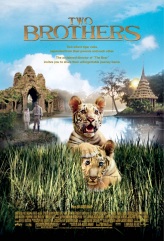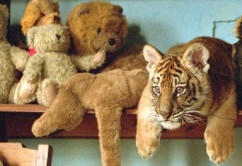| Two Brothers |
| |
 |
France/UK, 2004. Rated PG. 109 minutes.
Cast:
Guy Pearce, Jean-Claude Dreyfus, Freddie Highmore, Oanh Nguyen, Philippine Leroy-Beaulieu, Moussa Maaskri, Vincent Scarito, Mai Anh Le, Jaran Phetjareon, Stéphanie Lagarde
Writers: Alain Godard & Jean-Jacques Annaud
Original Music: Stephen Warbeck
Cinematography: Jean-Marie Dreujou
Producers: Jean-Jacques Annaud, Jake Eberts
Director: Jean-Jacques Annaud
LINKS
|
 here's a certain kind of film Jean-Jacques Annaud knows how to make. We're not talking about The Name of the Rose, Seven Years in Tibet, or Enemy at the Gates. These aren't bad films, but they're not where Annaud's skills lie. His skills lie in telling naturalistic stories from non-modern or even non-human points of view, using cinematography and music to bridge the gap in language. In Quest for Fire, prehistoric tribesmen go searching for the secret of creating fire, communicating only via rudimentary language and gestures. In The Bear, a film almost entirely free of dialogue, Annaud told the story of the relationship between two wild bears, and their confrontation with two hunters.
here's a certain kind of film Jean-Jacques Annaud knows how to make. We're not talking about The Name of the Rose, Seven Years in Tibet, or Enemy at the Gates. These aren't bad films, but they're not where Annaud's skills lie. His skills lie in telling naturalistic stories from non-modern or even non-human points of view, using cinematography and music to bridge the gap in language. In Quest for Fire, prehistoric tribesmen go searching for the secret of creating fire, communicating only via rudimentary language and gestures. In The Bear, a film almost entirely free of dialogue, Annaud told the story of the relationship between two wild bears, and their confrontation with two hunters.
Though Two Brothers isn't quite as honest and unsentimental in its depiction of the animal world as The Bear, there is still much to recommend it. The film begins at the beginning, as a documentary would, with the act of mating somewhere in Southeast Asia, sometime in the first half of the 20 th Century. The two resulting tiger cubs, later named Kumal and Sangha by humans, grow and explore, living a happy, carefree existence. It is their misfortune, however, to live in a ruined Buddhist temple, where they run afoul of treasure hunters led by adventurer Aidan McRory (Guy Pearce). Kumal winds up with a skanky circus, and Sangha in the personal zoo of a spoiled local prince (Oanh Nguyen) after an unsuccessful stint as the pet of the French administrator's son, Raoul (Freddie Highmore of Finding Neverland).

Although not representative of the film, this is one of the outrageously cute tiger cub moments in Two Brothers. |
Kumal and Sangha (played by an assortment of cubs) are outrageously cute, and Annaud's cameras—no doubt as a result of extreme patience and hard work—capture many magical moments. It's fascinating to watch the (relatively) tiny cubs bat around a gourd just as a pair of domestic housecats would, or to see them wading—we always hear that felines avoid water, but tigers actually love it. A startling moment of recognition comes when Momma Tiger rebukes Sangha for messing around where he shouldn't, almost exactly in the same way a human parent would.
The film achieves high drama when the hunters close in, but even more so when Momma Tiger approaches the human campground searching for her captured cub, communicating with him from a distance with roars. Although the villagers drive her off, tigers are not so easily dissuaded. Prepare to be amazed when she comes after the transport truck. There are heartbreaking moments, too, like when an aging tiger revives a confused, despondent Kumal at the circus only to be rendered superfluous by the cub's arrival, and therefore worth more dead than alive.
Humans kill animals with a shocking casualness in Two Brothers (which is why this film is rated PG, not G). Annaud doesn't depict it graphically, but that's the truth of the world. There is no longer a place for the tiger, something Annaud strongly regrets. He constantly draws attention to the artificial constructs of civilization, so ridiculous alongside the pure, straightforward existence of a tiger. Some humor is to be found in these juxtapositions as well, like when the humans run for a cage when the animals get free, and when even a goldfish finds its freedom. Despite the lighter moments and the inevitable happy ending, the grim reality—that our tiger population is in mortal danger—is inescapable, without Annaud ever having to say the words.
The film falls a bit short, however, by not being realistic about tigers actually being killers themselves, and by being unclear on other points of their existence. Mom and Dad are never shown bringing down prey to feed their young, for example. Also, animals recognize each other by smell and not by gazing deeply into each other's eyes. (Nonetheless, I defy any animal lover not to tear up with Kumal and Sangha reunite, even if it is a little faux.) Finally, when Sangha is taken away from Raoul because the tiger has “tasted blood,” that explanation is just too vague. Meat is all a tiger eats. It's not because Sangha has tasted blood; it's because Sangha has tasted blood as a consequence of attacking another animal, thus learning that he can obtain food for himself rather than waiting to be fed, and therefore becoming a danger. Thus Two Brothers paints a slightly misleading, confusing picture of the great cat.
Of course, these are minor points, particularly for a family film. You don't have to worry about your eight-year old running out to play with the dangerous man-eating tigers down at the end of the lane after seeing Two Brothers—unless, of course, you happen to have dangerous man-eating tigers living down at the end of the lane. Two Brothers is a top-notch, artfully made movie that contains a much stronger dose of reality than most family films. Would that Annaud made this type of movie more often!
Note: The DVD release of Two Brothers contains a generous offering of special features that will allow children to expand significantly their knowledge of tigers. This includes a documentary called Wild About Tigers (originally shown on Animal Planet), wherein we learn that the cats live only in Asia, that they can swim, and that they can survive from a surprising minus 40º to plus 50º Celsius. Unfortunately the sound mix is not very good—Pearce's narration often drops below the ambient noises. Other special features include:
- “Jean-Jacques Annaud's Journal”
- Feature Audio Commentary with director Jean-Jacques Annaud
- “Call of the Wild” (a short montage of tiger roars set to music)
- “Tiger Trainers” (the Two Brothers trainers speak about working with the film's tigers)
- “Tiger Brothers” (a look at the how many cubs it took to play the tiger brothers)
- “Tiger Tech” (about how the filmmakers created the scenes too dangerous to be filmed with live tigers)
- “Tiger Cam ” (about the cameras and techniques used to capture the tigers in their natural element)
- Location Scouting
- Costume Design
- Story Boards
Review
© January 2005 by AboutFilm.Com and the author.
Images © 2004 Universal Pictures. All Rights Reserved.


